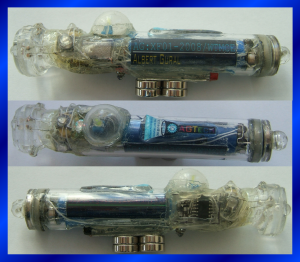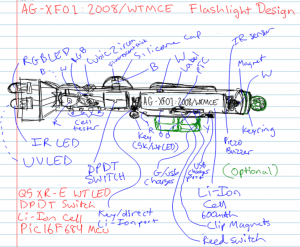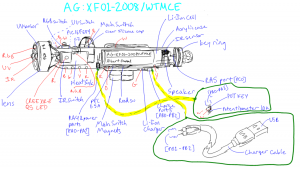The AGXF Series Flashlight(s) extended upon the AGUF flashlight series. The main goals of this line of flashlights was to include even more functionality (including the incorporation of a microcontroller – the first I’d ever use), than the AGUF flashlights. Besides more functionality, this flashlight would incorporate a hard plastic case (like the AG:UF15) and have innovations such as LEDs cast directly into the focusing lens. To date, I consider this one of my most advanced projects in terms of difficulty and time commitment, as well as one of my most successful. I’ve continued to use this flashlight for 2.5 years, and it still works (although at this point, the Li-Ion has pretty much died).
Design
I actually spent a LONG time working on the design of this flashlight. I probably started in Spring of 2008 and continued working on the design throughout the summer. I even remember working on the design during summer school (which I only took to get a history credit out of the way).
There were many aspects of the design to consider. The first one I started with was physical appearance and functionality – what should the flashlight be able to do, and where should the components be placed to optimize the design? What should the overall design look like? I drew the first few designs on paper, then for fun, I tried using my tablet for the final designs (worked out quite nicely!).
I actually spent a lot of time putting in as much detail as possible into these sketches. On the one above, you can see my plans for LEDs embedded in a lens, along with the switch and battery. Even looking back on it now, I can tell what the objects in the picture are, but you probably can’t. Here are some more sketches I made; this time with labels:
Actually, the aspect ratio on the image above is slightly off, but oh well. As you can see, it closely resembles the first design, but also includes color coded parts.
Finally, this last sketch includes all the labels from the second sketch, plus a description of some flashlight extensions (the USB charger and the potentiometer-controlled brightness key). After completing these sketches, I had a pretty good idea of what components and functions the flashlight should have. Finally, to sum everything up, I created a (long) features list.
- PIC16F684 microcontroller
- Most lights powered by microcontroller
- Li-Ion cell
- Cree Q5 XR-E LED
- IR, RGB, UV, controllable R,G,B LED’s
- Constant on backlights for Main switch and power ports
- Other backlights
- All switches have backlights
- 8 main modes:
- W: main output mode
- R: Hyperthermia mode
- Y: Flashing Output mode
- Has selectable sub-modes and levels of sub-modes
- G: IR receive mode
- C: IR + Warning mode (put out SOS)
- B: Hypothermia mode
- V: Sound Output mode
- Has selectable sub-modes and levels of sub-modes
- F: Backlights/ Display mode
- IR controlled: W, IR, RGB, UV, speaker, backlights
- Reed switch master shutoff switch
- PTC short-circuit protection switch
- Thermometer to measure White LED (including IR control):
- auto LED lower power when >70C and beep warning
- LED shutoff when >90C and beep warning
- USB battery charge or external wall mount charge (5V)
- Battery Level indicator: L-H: red, yellow, green, blue
- Periodically sends out IR signal (mode, device)
- Latching main switch
- IR, RGB, and IR LED’s embedded in lens
- CZ on top of R,G,B controllable LED
- Other various magnets and a key ring
- WDT enabled to ensure continued running of MCU
- Plastic case & glued parts for ruggedness
- ≤250 Lumens of light output



